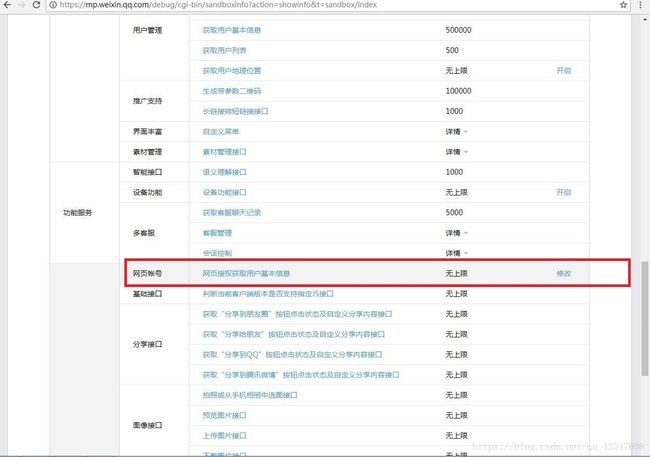微信公众号授权登录、获取用户信息(openid)
配置微信公众号开发环境就不赘述了。
进入正题。。。。。
首先,先理清楚微信登录的两种实现途径(这里我们先演示一种)1.微信开放平台实现,2.微信公众号(微信公众平台)实现。
因为微信登录不同与QQ登录,微信登录只提供扫码方式登录,并不像其他应用登录让用户输入用户名,密码。对用户并不友好。所以出现微信公众号登录,让用户授权。
实现方式也是两种:
1.没有自己的帐号体系,直接拉去微信用户信息来进行网站登录(我们所展示的信息全部来自于微信)
2.有自己的账号体系,授权成功后需要绑定自己的账号,绑定成功后,下次登录所展示的信息是自己的账号体系下面的用户信息
下面开始
1.微信公众号,推荐使用测试账号(拥有所有权限)
2.看微信授权登录的文档
3.代码部分了(尽可能的加上了注释)
工具类
package com.wlw.util;
import java.io.IOException;
import org.apache.http.HttpEntity;
import org.apache.http.HttpResponse;
import org.apache.http.client.ClientProtocolException;
import org.apache.http.client.methods.HttpGet;
import org.apache.http.impl.client.DefaultHttpClient;
import org.apache.http.util.EntityUtils;
import net.sf.json.JSONObject;
/**
*
* 工具类
* 用来根据接口地址进行网络请求
* @author wlw
*
*/
public class AuthUtil {
public static final String APP_ID = "****************"; //填写自己的APPID
public static final String APP_SECRET = "**************"; //填写自己的APPSECRET
public static JSONObject doGetJson(String url) throws Exception, IOException {
JSONObject jsonObject=null;
//初始化httpClient
DefaultHttpClient client=new DefaultHttpClient();
//用Get方式进行提交
HttpGet httpGet=new HttpGet(url);
//发送请求
HttpResponse response= client.execute(httpGet);
//获取数据
HttpEntity entity=response.getEntity();
//格式转换
if (entity!=null) {
String result=EntityUtils.toString(entity,"UTF-8");
jsonObject=JSONObject.fromObject(result);
}
//释放链接
httpGet.releaseConnection();
return jsonObject;
}
}
组装入口地址
package com.wlw.servlet;
import java.io.IOException;
import java.net.URLEncoder;
import javax.servlet.ServletException;
import javax.servlet.annotation.WebServlet;
import javax.servlet.http.HttpServlet;
import javax.servlet.http.HttpServletRequest;
import javax.servlet.http.HttpServletResponse;
import com.wlw.util.AuthUtil;;
/**
* 组装入口地址
* 进行授权页面的授权地址组装
* @author wlw
*
*/
@WebServlet("/wxLogin")
public class LoginServiet extends HttpServlet{
@Override
protected void doGet(HttpServletRequest req, HttpServletResponse resp) throws ServletException, IOException {
//回调地址(必须在公网进行访问)
String backUrl="http://w.ngrok.xiaomiqiu.cn/we/callBack";
String url="https://open.weixin.qq.com/connect/oauth2/authorize?appid="+AuthUtil.APP_ID
+ "&redirect_uri="+URLEncoder.encode(backUrl)
+ "&response_type=code"
+ "&scope=snsapi_userinfo"
+ "&state=STATE#wechat_redirect";
//重定向
resp.sendRedirect(url);
}
@Override
protected void doPost(HttpServletRequest req, HttpServletResponse resp) throws ServletException, IOException {
// TODO Auto-generated method stub
super.doPost(req, resp);
}
}
到这里很多人不明白回调地址到底是个啥玩意,
回调地址是当我们用户同意授权后,程序会进行对回调地址的访问。所以回调地址必须在公网上能够进行访问的。
还有个重点是scope(授权的作用域)。两个参数snsapi_base、snsapi_userinfo。。使用base作用域,不会弹出会话框,直接跳过,直接进入到回调地址,运行之后的程序,它默认是授权的(只能获取到openid)。。而userinfo,会弹出会话框,让用户选择,确认,才会进入回调地址(获取openID,通过openID拿到其他信息),用户取消则不进入回调地址。
微信公众号的bug之一就出现了,如果先使用userinfo作用域,再去使用base作用域,居然也能获取到用户的其他信息。至于为什么就要去问微信的开发大佬了。
回调地址的处理
package com.wlw.servlet;
import java.io.IOException;
import javax.servlet.ServletException;
import javax.servlet.annotation.WebServlet;
import javax.servlet.http.HttpServlet;
import javax.servlet.http.HttpServletRequest;
import javax.servlet.http.HttpServletResponse;
import com.wlw.util.AuthUtil;
import net.sf.json.JSONObject;
/**
* 回调地址
*
* @author wlw
*
*/
@WebServlet("/callBack")
public class CallBackServlet extends HttpServlet {
@Override
protected void doGet(HttpServletRequest req, HttpServletResponse resp) throws ServletException, IOException {
/**
* 3.获取code
*/
String code=req.getParameter("code");
String url="https://api.weixin.qq.com/sns/oauth2/access_token?appid="+AuthUtil.APP_ID
+ "&secret="+AuthUtil.APP_SECRET
+ "&code="+code
+ "&grant_type=authorization_code";
JSONObject jsonObject;
try {
jsonObject = AuthUtil.doGetJson(url);
String openid=jsonObject.getString("openid");
String token=jsonObject.getString("access_token");
/**
* 4.拉取用户信息
*/
String infoUrl="https://api.weixin.qq.com/sns/userinfo?access_token="+token
+ "&openid="+openid
+ "&lang=zh_CN";
JSONObject userInfo=AuthUtil.doGetJson(infoUrl);
System.out.println(userInfo);
//使用微信用户信息直接登录,无需注册和绑定
req.setAttribute("info", userInfo);
req.getRequestDispatcher("/index1.jsp").forward(req, resp);
} catch (Exception e) {
// TODO Auto-generated catch block
e.printStackTrace();
}
}
@Override
protected void doPost(HttpServletRequest req, HttpServletResponse resp) throws ServletException, IOException {
// TODO Auto-generated method stub
super.doPost(req, resp);
}
}
index.jsp
<%@ page language="java" contentType="text/html; charset=UTF-8"
pageEncoding="UTF-8"%>
Insert title here
微信公众 版权登录
index1.jsp
<%@ page language="java" contentType="text/html; charset=UTF-8"
pageEncoding="UTF-8"%>
Insert title here
登录成功!
用户昵称: ${info.nickname}
用户头像:  登录成功!
登录成功!
截图配置信息
写自己的域名。。。不要带http
参考图2 截图配置信息 这里应该填 1afa5dc0.ngrok.io
然后在浏览器输入地址访问,会显示需要在微信端进行访问.
只需将地址换成二维码,扫描即可。如何换成二维码呢,我建议使用谷歌浏览器,方便,直接在地址栏右击,就会有二维码。扫一扫即可。
微信扫描,点击授权,登录进去页面显示
后台获取到的数据
原理就是两个Servlet和两个JSP页面。一个是用户进入的登录页面,只不过不用输入用户名密码,直接授权登录。另外一个页面为展示用户的数据。两个Servlet配合JSP页面处理后台。
这一次演示的是没有自己帐号体系,不需要绑定,直接登录。
帐号体系的授权登录自行百度。







